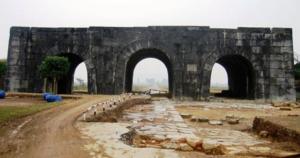Archeologists Discover Intact Buffalo Skeleton at Nam Giao Worshipping Platform

An undamaged skeleton of an animal was dug by Vietnamese archaeologists at the Ho Citadel in Vinh Loc Commune. The skeleton was found to be of a buffalo, and was unearthed beneath a wall that surrounds the Nam Giao worshiping platform. The archaeologists believe the buffalo was sacrificed in 1402, when the platform was built.
Located at the foot of Dun Son Mountain, this stage is built of stones and rocks and is very solid. This unique structure was used by kings for rituals and prayers. Built under the King Ho Han Thuong, it is used by Ho dynasty to make ceremonial offerings. It was destroyed over the centuries but after 4 archaeological excavations in 2004, the overall ground of the Nam Giao relic was gradually uncovered which makes up the base and the overall space of the stage.
In 2007, archeologists began the second phase of its excavation where thousands of architectural items were collected and analyzed to help solve the mysteries surrounding the worshipping stage. Its overall space still intact, and being the oldest in Vietnam, the Nam Giao worshiping platform is considered an extremely rare type of relic in the country.
The found skeleton is believed to be the first such discovery in the history of archaeology in Viet Nam. Nothing similar had been found at the worshipping platforms of different dynasties across Vietnam. The fact the buffalo skeleton was buried directly underneath the biggest surrounding wall of the platform led scientists to believe it was used as an offering.
After research and analysis, the skeleton will be restored for display at the Ho Citadel, a UNESCO World Heritage site.









